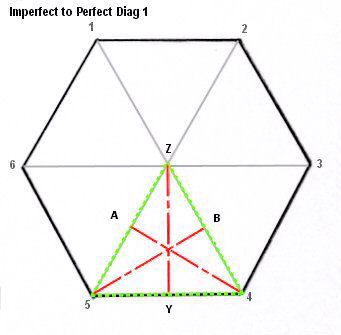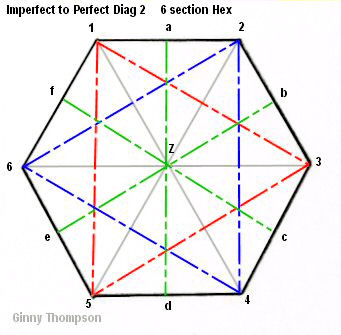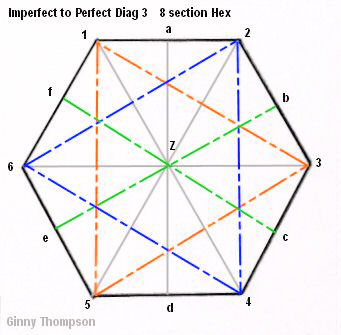Multiple faces from 10-Combination Division - Upgrading from Imperfect to Perfect
As has been discussed, the first criteria for a multiple-face marking being perfect when the initial extra marking lines are laid down is that each hexagon has 12 wedges. Some hexagons will be perfect, others will not. A hexagon divided into 12 wedges is perfect. The hexagons that have 6 or 8 wedges are imperfect. Further subdividing these hexagons by adding marking lines in each wedge not only
 finishes each hexagon into a perfect one, it works with its neighbors to
increase the number of faces on the total marking, which is the purpose
of increasing a marking from imperfect to perfect. This is how the
higher-valued multiple face markings are achieved. It is done not just
by adding a perpendicular drop from the center point (z) to the midpoint
of the side (y), but goes a bit further so that the additional faces are
formed. It also adds lines A4 and B5, which when continued throughout
the hexagon, interact with those in adjacent shapes to complete the
marking.
finishes each hexagon into a perfect one, it works with its neighbors to
increase the number of faces on the total marking, which is the purpose
of increasing a marking from imperfect to perfect. This is how the
higher-valued multiple face markings are achieved. It is done not just
by adding a perpendicular drop from the center point (z) to the midpoint
of the side (y), but goes a bit further so that the additional faces are
formed. It also adds lines A4 and B5, which when continued throughout
the hexagon, interact with those in adjacent shapes to complete the
marking. Locate Wedge Z-4-5 in Diag 1 to the right. Adding the extra lines shown in red convert the wedge into a 6-section triangle. As these lines are added, many more centers are added the mari marking, creating more pentagon-hexagon sets. As the process continues and is completed, each pentagon and hexagon will result in being perfect - 10 wedges in each pentagon and 12 wedges in each hexagon

In the case of of a 6-wedge hexagon, it's easier to see and stitch if you think of adding lines to complete the marking as sets, shown in the diagram to the left. The gray lines going from center to corners are the ones laid down in the original marking for a multiple face. Note that they divide the hexagon into six wedges. The goal is to have 12 wedges, each of which is divided into 6 small triangles. Visualize adding the green dashed lines to gain the 12 wedges, then add the blue and red dashed line triangles to complete the hexagon.
 For an 8-wedge
hexagon, one less green line is required, since two wedges already have
a vertical in them. For these hexagons, you need to add the 2 green
lines b-e and c-f, along with the red and blue triangles.
For an 8-wedge
hexagon, one less green line is required, since two wedges already have
a vertical in them. For these hexagons, you need to add the 2 green
lines b-e and c-f, along with the red and blue triangles.Depending on the size mari you are working and the number of centers, you can develop your own stitching rhythm for adding the extra lines - some people continue to work within each hexagon, others will "spot" along the mari and carry threads longer through groups of shapes. The goal is to arrive at the end point of no more wedges that can be subdivided into 6 parts; at that point all pentagons and hexagons will be perfect, with 10 wedges and 12 wedges respectively, throughout all of the new centers that were created in this process. Continuing a multi-face marking from imperfect to perfect greatly increases the number of centers on the marking. Indeed, progressing in this manner is the only way to achieve some multi-face totals. For example, if you wanted to mark out a 122 face mari, you first follow the basic procedure to mark a 42-face using the 4-part diamond division. When that is complete, you work the additional lines described above in each hexagon as needed to bring them to perfect status. The reference charts indicate the starting marking (imperfect column), and what will result with upgrading to perfect status (perfect column).
Lessons
and translations (with deep appreciation): Ai M.
Direct translation and translation assistance: Milly K., Kiyoko T.;
Publications: Kaga Hana Temari (ISBN4-8377-0292 -9), Sosaku Temarizikushi (ISBN4-8377-0696-7), Edo Temari (ISBN4-8377-0394-1)
Direct translation and translation assistance: Milly K., Kiyoko T.;
Publications: Kaga Hana Temari (ISBN4-8377-0292 -9), Sosaku Temarizikushi (ISBN4-8377-0696-7), Edo Temari (ISBN4-8377-0394-1)
This is a TemariKai.com Printable Page; © 2014, all rights reserved. Right click to print one copy for personal use.
Last updated 1/2014 © 1998 - 2014 TemariKai.com, G. Thompson/PuffinStuff, Inc.
